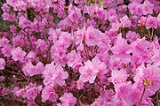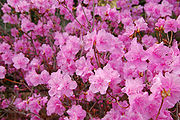
Hwajeon
Encyclopedia
Hwajeon is a small, sweet pancake
or tteok
(rice cake) made of any edible flower
petal
s such as azalea
or chrysanthemum
and glutinous rice
flour
, and sugar in Korean cuisine. Its name means "flower cake" in Sino-Korean, and also can be referred to as kkot bukumi (꽃부꾸미), kkot jijimi (꽃지지미), kkot darim (꽃달임) in native Korean language
.
 Hwajeon was commonly eaten at hwajeon nori (화전놀이), a traditional custom held since the Goryeo dynasty (918-1392), literally meaning "flower cake play". In spring, women went on a picnic carrying with them glutinous rice flour and beoncheol (번철, a thick frying pan photo) near a stream on Samjinnal
Hwajeon was commonly eaten at hwajeon nori (화전놀이), a traditional custom held since the Goryeo dynasty (918-1392), literally meaning "flower cake play". In spring, women went on a picnic carrying with them glutinous rice flour and beoncheol (번철, a thick frying pan photo) near a stream on Samjinnal
which falls on every March 3 in the lunar calendar
. They plucked azaleas or any available edible flowers at hand where they set up their picnic and made hwajeon with the ingredients. The version made with edible azaleas (Rhododendron mucronulatum
) is called jindallae hwajeon (진달래화전) or dugyeon hwajeon (두견화전
), and is regarded as the most representative hwajeon. It was traditionally eaten together with jindallae hwachae
, or traditional punch
consisting of the same flower floating in honey
ed water or omija juice (Schisandra chinensis
berries).
Similarly, people enjoyed hwajeon nori in autumn as making another variety of hwajeon that is made with chrysanthemum
flowers and leaves. It is called gukhwajeon (국화전) and consumed with gukhwaju (국화주, rice wine
made with the flower), or yuja hwachae
(yuzu
punch
). Gukhwajeon is closely related to the Korean traditional festival called Junggu (중구 重九) or Juyangjeol (중양절). It falls on every 9th day of September in the Korean calendar
.
cake) are made and eaten in spring, On the other hand, jangmi hwajeon (장미화전) made with rose
s is eaten in early summer. and maendrami hwajeon (맨드라미화전 Celosia cristata Linne
cake) in autumn.
If no actual flowers are available, water dropwort
, ssuk
, seogi, jujube
may be used in their place to make a flower-like decoration on the kneaded dough.
Jeon (food)
Jeon , buchimgae, jijimgae, or jijim refer to many pancake-like dishes in Korean cuisine. It has been also called jeonyueo or jeonyuhwa, especially in Korean royal court cuisine. Sometimes, jeonya is used as an abbreviated term for the two...
or tteok
Tteok
Tteok is a class of Korean rice cakes made with glutinous rice flour , by steaming. Normal rice flour can be used for some kinds of tteok. There are hundreds of different kinds of tteok eaten year round...
(rice cake) made of any edible flower
Edible flowers
Edible flowers are flowers that can be consumed safely. Edible flowers may be preserved for future use using techniques such as drying, freezing or steeping in oil. They can be used in drinks, jellies, salads, soups, syrups and main dishes. Flower-flavoured oils and vinegars are made by steeping...
petal
Petal
Petals are modified leaves that surround the reproductive parts of flowers. They often are brightly colored or unusually shaped to attract pollinators. Together, all of the petals of a flower are called a corolla. Petals are usually accompanied by another set of special leaves called sepals lying...
s such as azalea
Azalea
Azaleas are flowering shrubs comprising two of the eight subgenera of the genus Rhododendron, Pentanthera and Tsutsuji . Azaleas bloom in spring, their flowers often lasting several weeks...
or chrysanthemum
Chrysanthemum
Chrysanthemums, often called mums or chrysanths, are of the genus constituting approximately 30 species of perennial flowering plants in the family Asteraceae which is native to Asia and northeastern Europe.-Etymology:...
and glutinous rice
Glutinous rice
Glutinous rice is a type of short-grained Asian rice that is especially sticky when cooked. It is called glutinous Glutinous rice (Oryza sativa var. glutinosa or Oryza glutinosa; also called sticky rice, sweet rice, waxy rice, botan rice, biroin chal, mochi rice, and pearl rice, and pulut) is a...
flour
Flour
Flour is a powder which is made by grinding cereal grains, other seeds or roots . It is the main ingredient of bread, which is a staple food for many cultures, making the availability of adequate supplies of flour a major economic and political issue at various times throughout history...
, and sugar in Korean cuisine. Its name means "flower cake" in Sino-Korean, and also can be referred to as kkot bukumi (꽃부꾸미), kkot jijimi (꽃지지미), kkot darim (꽃달임) in native Korean language
Korean language
Korean is the official language of the country Korea, in both South and North. It is also one of the two official languages in the Yanbian Korean Autonomous Prefecture in People's Republic of China. There are about 78 million Korean speakers worldwide. In the 15th century, a national writing...
.
Hwajeon nori

Samjinnal
Samjinnal is one of sesi pungsok or Korean traditional customs by season, which falls on every March 3 in the lunar calendar. It was called samjil in old Korean language and referred to as sangsa , wonsa , sungsam , sangje or dapcheongjeol in hanja. Samjinnal implies the overlapping of Sam...
which falls on every March 3 in the lunar calendar
Lunar calendar
A lunar calendar is a calendar that is based on cycles of the lunar phase. A common purely lunar calendar is the Islamic calendar or Hijri calendar. A feature of the Islamic calendar is that a year is always 12 months, so the months are not linked with the seasons and drift each solar year by 11 to...
. They plucked azaleas or any available edible flowers at hand where they set up their picnic and made hwajeon with the ingredients. The version made with edible azaleas (Rhododendron mucronulatum
Rhododendron
Rhododendron is a genus of over 1 000 species of woody plants in the heath family, most with showy flowers...
) is called jindallae hwajeon (진달래화전) or dugyeon hwajeon (두견화전
Hangul
Hangul,Pronounced or ; Korean: 한글 Hangeul/Han'gŭl or 조선글 Chosŏn'gŭl/Joseongeul the Korean alphabet, is the native alphabet of the Korean language. It is a separate script from Hanja, the logographic Chinese characters which are also sometimes used to write Korean...
), and is regarded as the most representative hwajeon. It was traditionally eaten together with jindallae hwachae
Jindallae hwachae
Jindallae hwachae is a variety of hwachae, or Korean traditional fruit punch, made with azalea petals and mung bean starch. It is prepared for Samjinnal .-External links:**...
, or traditional punch
Hwachae
Hwachae is a general term for Korean traditional punches made with various fruits or edible flower petals soaked in omija or honeyed juice.-Types:...
consisting of the same flower floating in honey
Honey
Honey is a sweet food made by bees using nectar from flowers. The variety produced by honey bees is the one most commonly referred to and is the type of honey collected by beekeepers and consumed by humans...
ed water or omija juice (Schisandra chinensis
Schisandra chinensis
Schisandra chinensis is a deciduous woody vine native to forests of Northern China and the Russian Far East. It is hardy in USDA Zone 4. The plant likes some shade with moist, well-drained soil...
berries).
Similarly, people enjoyed hwajeon nori in autumn as making another variety of hwajeon that is made with chrysanthemum
Chrysanthemum
Chrysanthemums, often called mums or chrysanths, are of the genus constituting approximately 30 species of perennial flowering plants in the family Asteraceae which is native to Asia and northeastern Europe.-Etymology:...
flowers and leaves. It is called gukhwajeon (국화전) and consumed with gukhwaju (국화주, rice wine
Rice wine
Rice wine is an alcoholic beverage made from rice. Unlike wine, which is made by fermentation of naturally sweet grapes and other fruit, rice "wine" results from the fermentation of rice starch converted to sugars...
made with the flower), or yuja hwachae
Yuja hwachae
Yuja hwachae is a variety of hwachae, Korean traditional fruit punch made with finely shredded yuja , bae and honey or sugar. In Korea, yuja are largely cultivated in the southern part of the Korean peninsula such as Goheung and Wando, Geoje, and Namhae...
(yuzu
Yuzu
The yuzu is a citrus fruit and plant originating in East Asia. It is believed to be a hybrid of sour mandarin and Ichang papeda...
punch
Hwachae
Hwachae is a general term for Korean traditional punches made with various fruits or edible flower petals soaked in omija or honeyed juice.-Types:...
). Gukhwajeon is closely related to the Korean traditional festival called Junggu (중구 重九) or Juyangjeol (중양절). It falls on every 9th day of September in the Korean calendar
Korean calendar
The traditional Korean calendar is a lunisolar calendar, like the traditional calendars of other East Asian countries. Dates are calculated from Korea's meridian, and observances and festivals are based in Korean culture....
.
Ingredients and varieties
In addition to jindallae hwajeon and gukhwajeon, any seasonal flower can be made as hwajeon if edible. Ihwajeon (이화전, 梨花煎, Korean pear flower cake), beotkkot hwajeon (벚꽃화전, cherry blossom cake), jebikkot hwajeon (제비꽃화전 Viola mandshuricaViola
The viola is a bowed string instrument. It is the middle voice of the violin family, between the violin and the cello.- Form :The viola is similar in material and construction to the violin. A full-size viola's body is between and longer than the body of a full-size violin , with an average...
cake) are made and eaten in spring, On the other hand, jangmi hwajeon (장미화전) made with rose
Rose
A rose is a woody perennial of the genus Rosa, within the family Rosaceae. There are over 100 species. They form a group of erect shrubs, and climbing or trailing plants, with stems that are often armed with sharp prickles. Flowers are large and showy, in colours ranging from white through yellows...
s is eaten in early summer. and maendrami hwajeon (맨드라미화전 Celosia cristata Linne
Celosia cristata
Celosia cristata [Celosia in Greek means burning] is a member of the genus Celosia, and is commonly known as cockscomb, since the flower looks like the head on a rooster . It is called Chi Kuan in China...
cake) in autumn.
If no actual flowers are available, water dropwort
Water dropwort
The water dropworts, Oenanthe , are a genus of plants in the family Apiaceae. Most of the species grow in damp ground, in marshes or in water....
, ssuk
Artemisia princeps
Artemisia princeps, or Japanese mugwort, is a perennial, very vigorous plant that grows to 1.2 meters and is known as yomogi in Japan. This species spreads rapidly by means of underground stolons and can become invasive. It bears small, buff colored flowers from July to November which are...
, seogi, jujube
Jujube
Ziziphus zizyphus , commonly called jujube , red date, Chinese date, Korean date, or Indian date is a species of Ziziphus in the buckthorn family Rhamnaceae, used primarily as a fruiting shade tree.-Distribution:Its precise natural distribution is uncertain due to extensive cultivation,...
may be used in their place to make a flower-like decoration on the kneaded dough.

